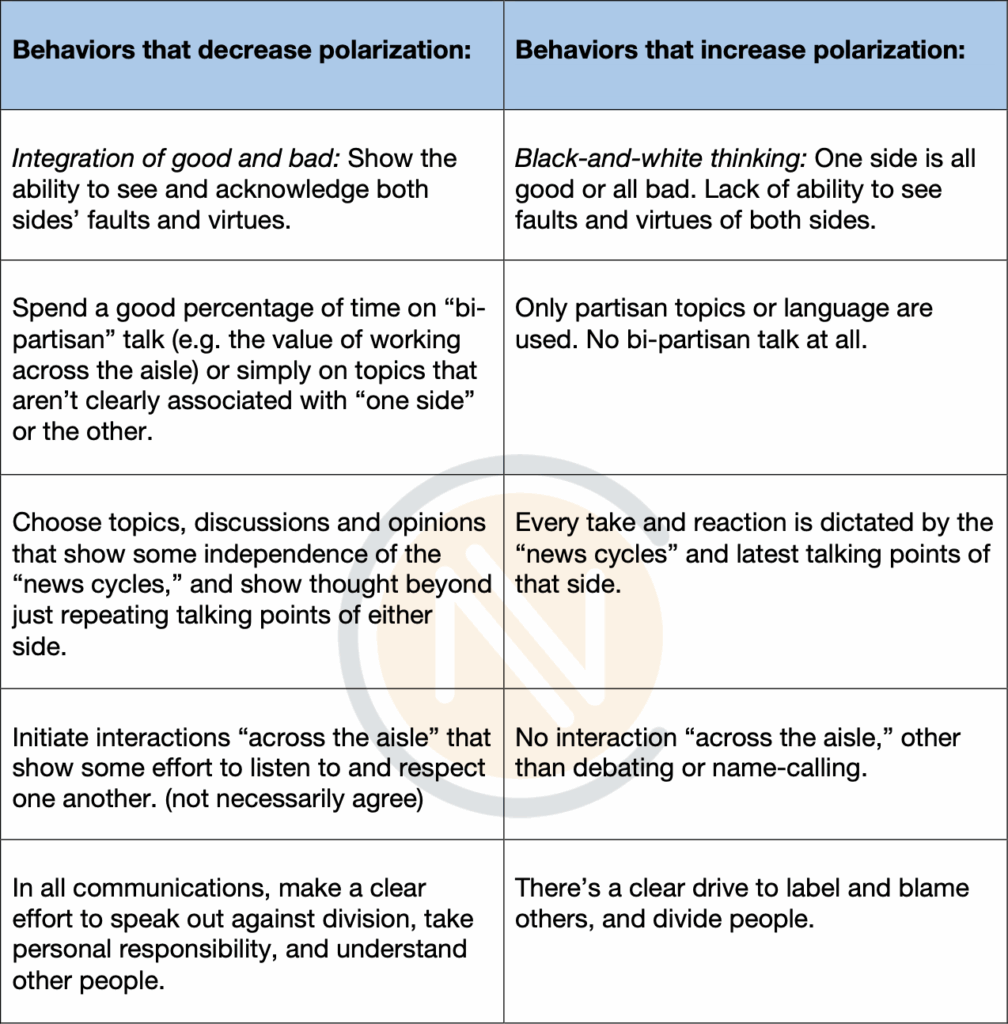I recently asked one of my mentors, “Do you think we’re living in the most challenging times you’ve seen?” He responded, “Maybe, but mostly because everything these days is so politicized.” I worked with one CEO who joked that at his church, anything could become a controversial issue, and they might call a public meeting just to vote on what kind of toilet paper was in the bathrooms!This isn’t just hearsay—many polls and statistics show that polarization is at near historic highs (Pew Research Center), and trust in people and in major institutions is about as low as ever (Gallup). In my view, these are symptoms of a high level of societal anxiety.
Everyone wants to know: what can be done about this? Can it improve? Certainly it can, but that doesn’t mean it’s easy. Consider an unstable industry threatening a company’s existence or sustenance. On some level, the industry will directly impact the anxiety level of the company, like it or not. Some of that may not be in their direct control. They may need to adapt some, and they may need to wait for the instability to pass, in some cases.
What about us? On an everyday level, how can we interact in ways that decrease polarization—whether we’re at work, school, church, home or online? Here are some starting ideas:

We might be used to the inflammatory nature of news sites and social media comments, but I’ve read plenty of thoughtful and nuanced articles in recent months and years that exhibit the behaviors listed in the left column! I’ve myself written comments that have successfully de-escalated and humanized specific online interactions. So I know this can work—and when we’re able to engage in behaviors that decrease polarization, there’s something “relieving” about it that other people can feel.
Now, it’s also true that when we try to de-escalate things, we often still receive pushback and negativity. That’s just the nature of how anxiety flows within a system. So we must try to remember that we’re engaging in these behaviors for ourselves and for people who know and love us—not primarily to change the masses, or the most “challenging” individuals.
Yes, this is all easier said than done. However, in the long run we might be surprised at how calm behavior and leadership can impact a group. I think of a leader I worked with, who provided clarity and stability at a time of great uncertainty in her company’s industry. She listened to her employees, prepared them as much as possible for potential outcomes, and set achievable goals to ensure they were ready when changes finally did happen.
When it comes to our society and the high level of polarization and anxiety around, an image that comes to mind is being at a crowded airport. I fly out of LAX (Los Angeles) airport all the time, and if you’ve ever been there or somewhere similar—everyone is going somewhere and when so many worlds collide, there’s a kind of stress level and pace that’s almost contagious. People are rushing and pushing past others, even in the security screening line. I used to joke with my wife that the TSA agents often sound like drill sergeants: “Get your laptops out of your bags! Now! Don’t you eyeball me, young man! Drop and give me 20 pushups!” Even if I’m not in a rush myself, my intensity level can increase because of the people and atmosphere around me.
I feel like something similar is happening in our current societal climate. We just feel the angst and unease in the air, and it impacts us whether or not we realize it. But in the past few years, I also realized something else about being at the airport. Sometimes I can be the one to slow down. There are times when I feel the person in line behind me pushing to go faster, and I just smile and tell them, “please go ahead, you can go first.” I’ve done this at grocery stores and the post office too, and when they thank me, I sometimes say, “No problem at all, I have enough time.”
I find that doing this helps me to slow and calm down. But in some cases, it actually helps that person to be a little calmer too. You might be surprised how powerful one calm person can be, in an anxious group or system!
And let’s not forget—there are societies where the overall pace of life is slower. I’ve been there and felt it! And I have to tell you, that can be contagious too! In one country, people were moving so agonizingly slow, that I almost fell asleep sitting on a bench on a public street. So changes can happen over a long period of time. But sometimes we need to start with small goals first—before the big, overwhelming ones.
Will you take on the challenge of being one calm individual who doesn’t go along with the masses—but interrupts the escalating cycle of polarization?
I teach the skills required to communicat e in challenging situations in my book The Art of Growing Through Feedback (now available in paperback and e-book). I’m offering bulk discounts up to 45% off + a free Q & A session with me! Please write me if you’re interested in using it for your team, company, book club, church, or other group.
e in challenging situations in my book The Art of Growing Through Feedback (now available in paperback and e-book). I’m offering bulk discounts up to 45% off + a free Q & A session with me! Please write me if you’re interested in using it for your team, company, book club, church, or other group.
Discussion or Reflection Questions:
- Think of a time when you chose to be the “calm one” in an anxious situation. What happened, what did you do, and what was the result? What did you learn from this experience?
- Applying these lessons to the workplace: What kind of anxiety or uncertainty is there in your industry? How does that impact people, and what kind of leadership do you think they need?
- What kinds of behaviors do you think can help to decrease polarization? Have you tried anything that has worked, or hasn’t worked? Please feel free to share ideas that aren’t listed in the chart above.
Thank you for reading this article! My name is Adrian Pei, and I’m the CEO of The Change Navigation Company, where we provide customized training for organizations and leaders. You can download a free pdf of this article by clicking on the icon below, which also contains a discount offer for our services. I hope we get a chance to connect soon!

